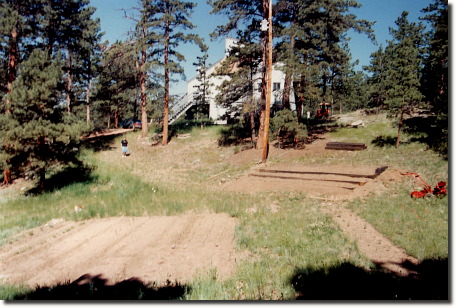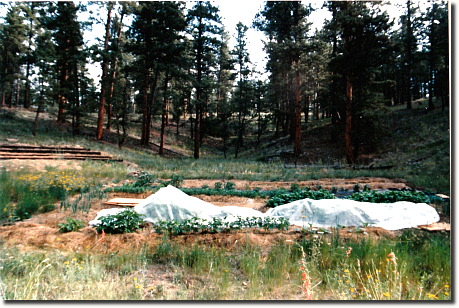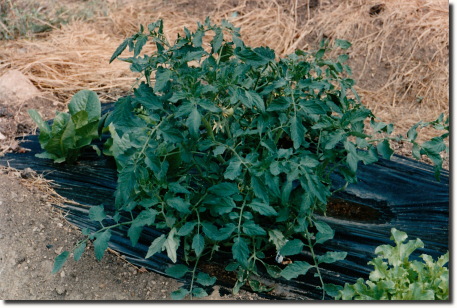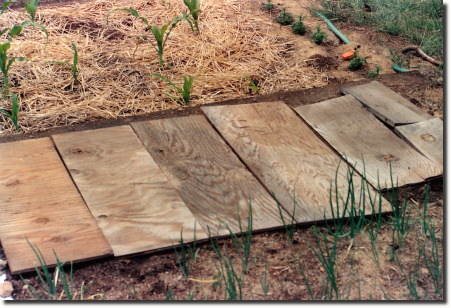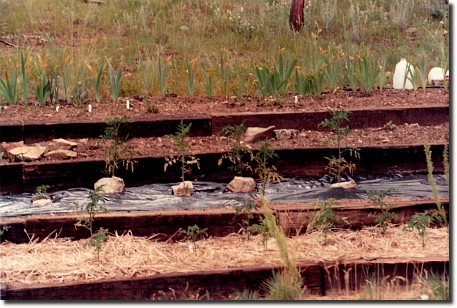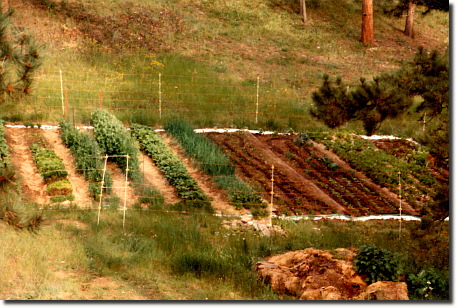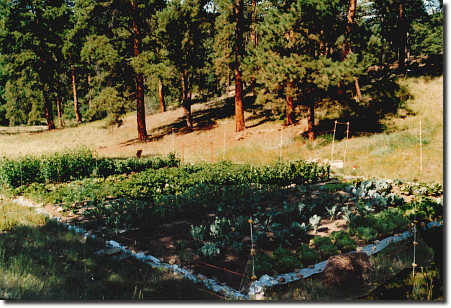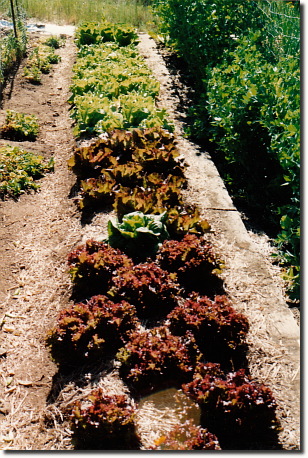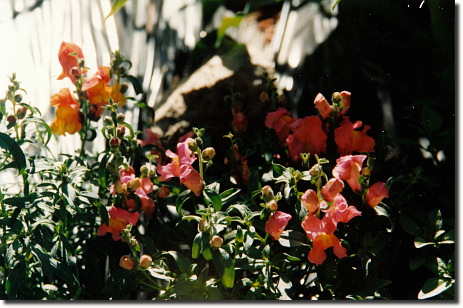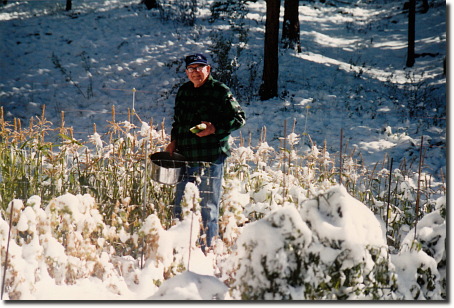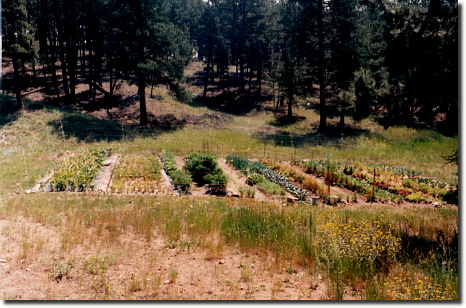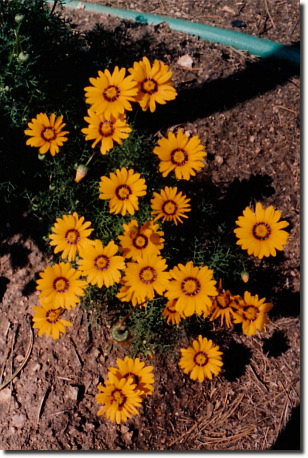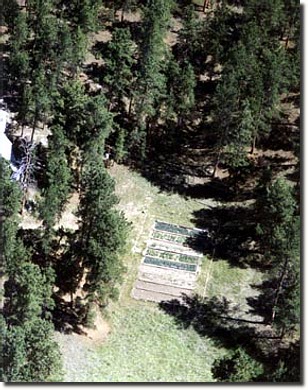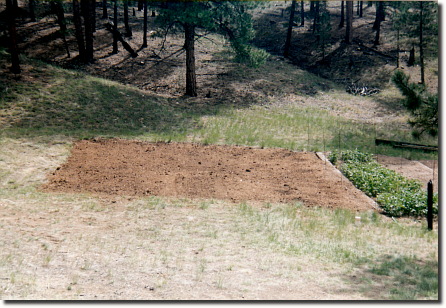Many vegetables grow well here. Greens such as spinach and swiss chard, lettuce, cole crops, carrots, beets, and onions appreciate the cool summer nights and well drained soil. Other vegetables such as tomatoes and corn are more challenging but can be successfully grown. For further information on high altitude gardening, click here to go to my High Altitude Gardening Tips section.
The following photo gallery shows some of my vegetable gardens since I moved to Colorado. I have tried many different techniques, some of which were successful and some not so successful. To me, gardening is a life long learning experience and I am always willing to try something new and different.
1988
This photograph shows my earliest attempt at gardening at high altitude. The bed I was creating on the hill side failed as the sun was too hot and I could not keep the plants watered enough. I eventually removed the bed and used the railroad ties in the vegetable garden to hold the soil on the sloping meadow. The long bed on the right held raspberries. Elk and deer love raspberry plants and this bed also failed in the long run.
1989
Here is a view of my vegetable garden, facing north, showing the slope of the land above the garden. Remay covers the tomato plants and other sensitive crops. Notice the abundance of wild flowers around the garden. The meadow is often filled with wild flowers.
I grew my tomato plants in black plastic this year with lettuce plants interspersed between the bigger plants. Notice the blooms on the tomato plant. The black plastic worked fairly well but the newer IRD plastic mulch works better as the suns heat rays can penetrate the newer plastics and warm the roots better.
1990
As I tilled my vegetable garden, I realized that the soil was sliding downhill. Here you can see where I've started adding railroad ties to create my beds. The original spacing of these ties was 5 feet apart.
1991
Seeds have a very difficult time germinating when planted directly in the garden here at high attitude. The sun is so strong the soil dries 4 inches down in a single afternoon. This photograph taken in 1991 shows how I used boards to shade the soil and hold in the moisture for germinating seeds. I check under the boards every day for germination so the seedlings don't suffer from lack of light and, subsequently, grow spindly.
This photograph shows how I lined my lettuce bed with aluminum foil to keep the rabbits and chipmunks out. It worked pretty well.
This was the last year that I used the tiered beds on the south facing hillside. As you can see, the iris leave tips are browned out as are the bottom leaves of the tomato plants. Even when I watered this bed every day and mulched heavily, the soil depth was too thin and the sun dried out the beds unmercifully.
1992
This photograph of my garden shows the electric fence that I use to keep the deer and elk out of the garden (mostly...). The shiny ring is aluminum foil that I placed around the entire garden to keep out rabbits and chipmunks, not just partial beds like the previous photograph. This worked for many years and then one day in 1996, the chipmunks realized that they could jump over the foil.
In the foreground is one of the few images I have of a good way of creating a compost pile up here. I used straw bales for the sides of the compost pile. The straw bales held in the moisture quite well and eventually I used the straw for mulch when it was fairly well rotten. This way, I did not have as many weed seed sprout from the straw.
1993
This photograph shows my vegetable garden this year, looking towards the south. The first beds are cabbage and other cole crops. Once again, I had the electric fence up and aluminum foil (held down with rocks) completely around the garden.
Here my lettuce bed for this year. Notice the lettuce is between two rows of peas growing on wire fences. The peas provided much appreciated shade for the lettuce.
For a few years I grew this variety of snap dragon along the edges of the wide rows. I love flowers but with so many wild flowers growing around the garden, cultivated flowers just don't seen appropriate.
1994
I grew some short stem sunflowers for seed this year. The holes in the leaves are from a major hazard up here - hail. The hail may fall through July and will shred the leaves of all the vegetables growing in my garden. The plants may look sad but they do continue to grow.
Here is a summer squash, ready for the picking.
1995
This photograph illustrates another of the hazards of gardening at high altitudes. The picture was taken in early September. My father is picking corn that was just ripening. The ears were frozen and we put them in the freeze with the husk on the ears. The snow covered plants in the foreground were my tomatoes.
1996
This shows my full garden with nine 5 foot beds, separated by railroad ties. I used the railroad ties as paths through the beds. We started a many year drought in 1996 as you can see by comparing the grass around my garden with previous photographs. The drought lasted many years with forest fires starting in 1997.
These are african daisies. African daisies grow very well up here as they quite accustomed to drought conditions and a lot of sun.
1997
This is a photograph taken from an airplane of my garden in July. I had only potatoes and corn with a few perennial onions planted as I was traveling that year. The cover crop that I planted in the unused beds never germinated as I was not home to water the garden and the drought was in full swing this year.
2002
I decided 5 foot beds were too difficult to plant as I could not reach the center of each bed without stepping into the bed. So, this year, I took out all the railroad ties, shortened the length of the garden and created three 9 foot beds. This way, I could put a path down the center of each bed and I could reach across the two parts and not step in the soft dirt as I planted and harvested vegetables.
I only had potatoes growing this transitional year. Notice how dry the area around the garden is. The drought was still in force.
2008
This is how my vegetable garden has looked for several years now. I have not been able to garden. The grass at the top and bottom of the garden where I shortened the length has finally grown in. I hope to plant some vegetables in 2009 but we'll have to see if we're home long enough to be able to water the garden through the summer.


